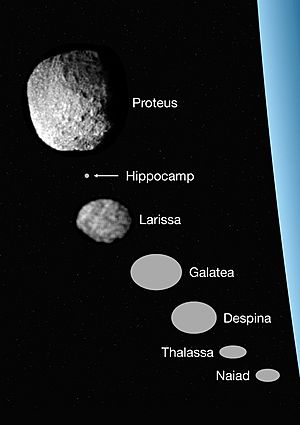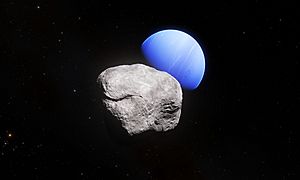Hippocamp (moon) facts for kids

This picture from the Hubble Space Telescope shows Neptune, its rings, and inner moons like Hippocamp (circled).
|
|
| Discovery | |
|---|---|
| Discovered by | M. R. Showalter I. de Pater J. J. Lissauer R. S. French |
| Discovery date | 1 July 2013 |
| Designations | |
| MPC designation | Neptune XIV |
| Pronunciation | /ˈhɪpəkæmp/ |
|
Named after
|
ἱππόκαμπος hippokampos |
| S/2004 N 1 | |
| Adjectives | Hippocampian /hɪpəˈkæmpiən/ |
| Orbital characteristics | |
| Epoch 1 January 2020 (JD 2458849.5) | |
| Earliest precovery date | 6 November 2004 |
| 105,283 km | |
| Eccentricity | 0.00084±0.00032 |
| 0.95 d (22.8 h) | |
| 329.901° | |
| Inclination | 0.0641°±0.0507° (to Neptune's equator) 0.0019° (to local Laplace plane) |
| 110.467° | |
| 305.446° | |
| Satellite of | Neptune |
| Physical characteristics | |
|
Mean radius
|
17.4±2.0 km |
| Mass | (1.029–30.87)×1015 kg |
| synchronous | |
| Albedo | ≈0.09 (assumed) |
| 26.5±0.3 | |
Hippocamp, also called Neptune XIV, is a tiny moon that orbits the planet Neptune. It was found on July 1, 2013. This moon is so small and dim that the Voyager 2 space probe did not see it when it flew past Neptune in 1989.
Hippocamp is about 35 km (20 mi) wide. It takes about 23 hours to orbit Neptune, which is a little less than one Earth day. Scientists think Hippocamp might have formed from pieces that broke off from Neptune's larger inner moon, Proteus, after a huge impact billions of years ago. In February 2019, it was officially named Hippocamp, after a sea-horse from Greek mythology.
Contents
Finding and Naming Hippocamp
How Hippocamp Was Discovered
A team of astronomers led by Mark Showalter found Hippocamp on July 1, 2013. Mark Showalter was looking through old pictures of Neptune taken by the Hubble Space Telescope in 2009. He was studying Neptune's ring arcs.
Neptune's inner moons and rings move very fast. Showalter used a special computer method to combine many short pictures. This made faint details show up better. He decided to look beyond the rings and found Hippocamp as a tiny, faint white dot.
To be sure, Showalter checked over 150 more Hubble pictures from 2004 to 2009. He found Hippocamp in many of these images. This helped him figure out the moon's orbit. The discovery was officially announced on July 15, 2013.
The Story Behind the Name
The moon is named after the hippocampus. This is a creature from Greek mythology that has the upper body of a horse and the lower body of a fish. The hippocampus is a symbol for the Greek sea god Poseidon and the Roman sea god Neptune. In stories, Neptune often rode a chariot pulled by hippocampi.
When it was first found, the moon was called S/2004 N 1. This name meant it was the first moon found around Neptune from pictures taken in 2004. Later, it was given the number Neptune XIV (14).
The International Astronomical Union (IAU) sets rules for naming moons. Neptune's moons must be named after figures from Greek or Roman mythology connected to Poseidon or Neptune. Mark Showalter suggested the name Hippocamp. He chose it because he loves scuba diving and the real-life seahorse animal. The IAU approved the name on February 20, 2019.
How Hippocamp May Have Formed
Neptune's moon system is very unusual. One moon, Triton, is much bigger than all the others combined. Scientists believe Triton was captured by Neptune long ago from the Kuiper belt. When Triton was captured, its orbit was very wild. This probably destroyed most of Neptune's original moons.
After Triton's orbit settled down, some of Neptune's current inner moons likely formed again from the leftover pieces. One of these moons is Proteus, which is the largest of Neptune's inner moons. Proteus has a huge crater called Pharos, which is more than half its own size. This means a giant impact must have almost shattered Proteus and sent a lot of material flying.
Hippocamp orbits very close to Proteus, only about 12,000 km (7,500 mi) away. Their orbits are quite similar. This suggests that both moons might have come from the same place in the past.
Scientists think Hippocamp might have formed from the pieces that flew off Proteus during the impact that created the Pharos crater. If this is true, Hippocamp would be like a "third-generation" moon of Neptune. This means it formed from impacts on moons that had already formed after Triton was captured.
Hippocamp is thought to have been hit by comets many times over billions of years. Each time, it would break apart and then come back together. These impacts helped make Hippocamp's orbit very round. Hippocamp might have lost some of its mass during these crashes.
What Hippocamp Is Like
Hippocamp is the smallest known moon of Neptune. It is estimated to be about 34.8 km (21.6 mi) across. It is about 1,000 times less heavy than Proteus.
We don't know much about Hippocamp's surface. Scientists think it looks dark, like Neptune's other inner moons. These moons have a dark, reddish surface. This color might come from organic compounds, which are common in the outer Solar System. Water ice is probably there too, but it's hard to see its signs.
Hippocamp's Orbit Around Neptune
Hippocamp takes about 22 hours and 48 minutes to go around Neptune. Its average distance from Neptune is 105,283 km (65,420 mi). This distance is about 4.3 times Neptune's radius. It's also a bit more than a quarter of the distance between Earth and our Moon.
Hippocamp orbits between two other moons, Larissa and Proteus. This makes it the second-farthest of Neptune's regular inner moons. Usually, moons get bigger the farther they are from the planet. But Hippocamp is very small for its distance.
Because Hippocamp is so close to the much larger Proteus, Proteus's gravity affects its orbit. Scientists can study how Proteus pulls on Hippocamp to estimate Proteus's mass.
Both Hippocamp and Proteus are slowly moving farther away from Neptune. This is due to tidal forces between them and the planet. Proteus moves away faster because it is bigger.
See also
 In Spanish: Hipocampo (satélite) para niños
In Spanish: Hipocampo (satélite) para niños



